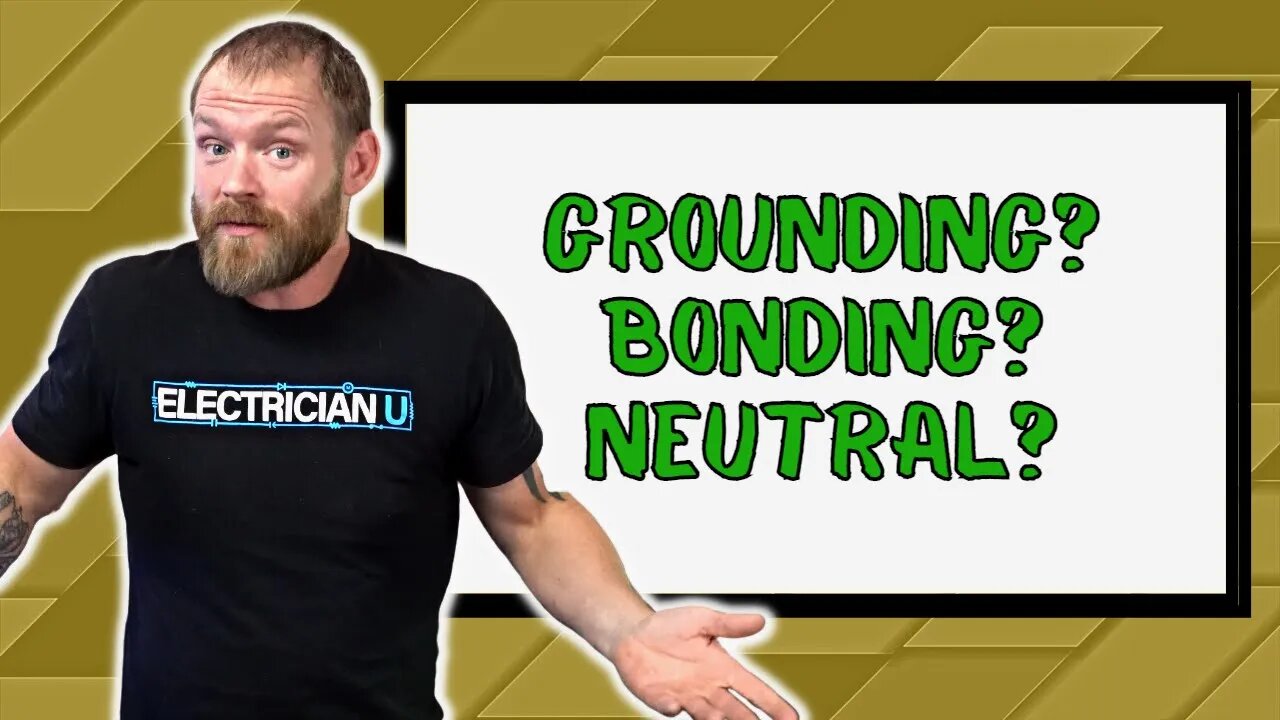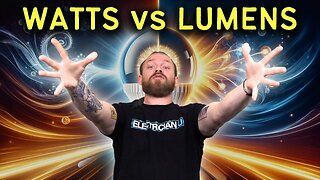Premium Only Content

What is the Difference Between Grounding, Bonding and Neutral?
Join this channel to get access to perks:
https://www.youtube.com/channel/UCB3jUEyCLRbCw7QED0vnXYg/join
When it comes to terms of the trade, nothing gets more misunderstood or confusing as the terms Grounding, Bonding, and Neutral. They seem to be used interchangeably back and forth and can even confuse many journeymen. In todays episode, Dustin defines these terms and brings some clarity to each one.
🤘⚡️MEMBERSHIP⚡️🤘
JOIN ELECTRICIAN U - become a member and get:
FREE Continuing Education every year
FREE Practice Exams
FREE Monthly Video Courses
FREE Weekly Live Instructor-Led Classes
FREE Monthly Educational Newsletter
Premium Members-Only Content
Private Discord Channel
Monthly Members-Only Discord Chats
Sign up here --- https://www.electricianu.com/electrician-u-membership/
🎧🎹MUSIC AND VIDEO:🎹🎧
https://www.facebook.com/descantmv
🎬✍️ART AND ILLUSTRATION:✍️🎬
https://www.daverussoart.com
First lets understand that while a Neutral is a type of Grounded Conductor but not every Grounded Conductor is a Neutral. A grounded conductor is a conductor that is intentionally brought to ground. So, for most electrical systems, a neutral IS a grounded conductor because it is bonded to ground, but under certain circumstances it doesn’t HAVE to be.
A grounding electrode is something that is in contact with the earth (ground). It could be a ground rod, plate, underground metallic structure, etc. A grounding electrode conductor is a piece of wire (conductor) that connects the grounding electrode to the ground bus within the system. This is separate from the Equipment Grounding conductor. Way back in the electrical trade, grounds were not run with the hots and neutrals that those systems still worked. However, in today’s trade, we generally run grounds with EVERYTHING, so it’s always present.
Let’s talk about Bonding Jumpers. A bond isn’t a neutral or a ground specifically. A bonding jumper connects two metallic pieces of equipment together in essence making one large piece of metal. A Main Bonding Jumper connects our Grounding bus and bonds it to the Neutral bus in our panel. Some panel manufacturers accomplish this by using those large green screws. That screw goes through the bus into the metallic portion of the panel therefore bonding the bus to the can. It can also be accomplished by running a piece of wire in between the ground bus and the neutral bus. The result is the same. If using wire, consult table 250.102(c)(1) in the NEC for sizing. A Supply Side Bonding Jumper connects anything metallic before the main breaker to the grounding system. So, since we don’t run grounds from the utility transformer to our service we have to be able to bond those metal cans with something. Enter the Supply Side Bonding Jumper! Separately derived systems also have a bonding jumper. Since we have bonded the neutral and ground at our service already, what happens at a transformer (say 480-120/208)? That is where the System Bonding Jumper comes in. This connects the XO (neutral in the transformer) to the grounding system (EGC, the transformer casing, etc.). This is also sized using table 250.102(C)(1) of the NEC.
The Equipment Grounding Conductor connects any piece of equipment to the grounding system. Panels, devices, equipment, etc. are all tied together (from a grounding standpoint). The purpose of this is to provide an alternate path to ground (safety) in the event that something happens so that the breaker will open and shut power off to the equipment having issues. Its merely there for safety reasons. Equipment Grounding Conductors can be sized using table 250.122 of the NEC and are based upon size of the breaker feeding the equipment, whereas the Bonding Jumpers sizes are derived using the size of the largest service entrance conductor. An Equipment Bonding Jumper in essence connects 2 pieces of equipment together from a Ground standpoint.
We hope this has been helpful in understanding the differences between Grounding, Bonding, and Neutral. Is there a topic you would like to see discussed on Electrician U? Leave us a comment in the comments section and let us know. Please continue to follow Dustin and Electrician U as we are constantly updating our content to assist our followers in becoming the best electricians that they can be.
#electrician #electrical #electricity #what's #the #difference #between #bonding #grounding #and #neutral
-
 6:27
6:27
Electrician U
1 year ago💡 Watts vs Lumens: The New Lighting Standard You Need to Know! 💡
7.46K6 -
 DVR
DVR
Robert Gouveia
2 hours agoNew Jail Video 'Discrepancies' DISCOVERED! FBI Burn Bag! Biden Appointee FIRED!
16.8K4 -
 15:18
15:18
T-SPLY
4 hours agoCNN DROPPED a NUKE On Democrats - Worst Polls Ever!
1.91K6 -
 7:21
7:21
SKAP ATTACK
7 hours agoNBA Execs Think the Bubble Championship is a Joke
2.34K2 -
 8:29
8:29
ARFCOM News
5 hours agoAG ~~REFUSES~~ To Stop Enforcing Unconstitutional Law | How Trump Plans To Give Guns Back To Felons
2.11K2 -
 LIVE
LIVE
LFA TV
23 hours agoLFA TV ALL DAY STREAM - FRIDAY 8/1/25
726 watching -
 1:23:12
1:23:12
Roseanne Barr
3 hours agoBlackmail Nation: The Epstein Cover-Up with Nick Bryant | The Roseanne Barr Podcast #109
73.9K38 -
 26:40
26:40
Michael Franzese
4 hours agoThe Self-Proclaimed King of the Mafia: Vito Genovese’s Fatal Throne
19.1K2 -

Nerdrotic
5 hours ago $6.84 earnedWe Stand Behind Sydney Sweeney | Naked Gun | Fantastic Flop? - Friday Night Tights 365
46.2K16 -
 1:02:28
1:02:28
Sarah Westall
4 hours agoTrump’s Economic Plan will Change the World Economic System. Will it Work? w/ Andy Schectman
21.8K5